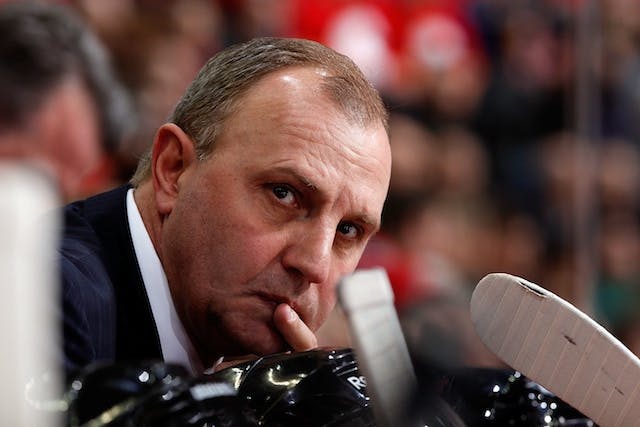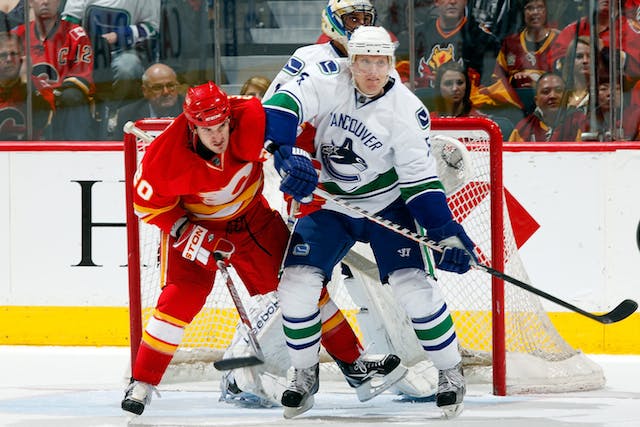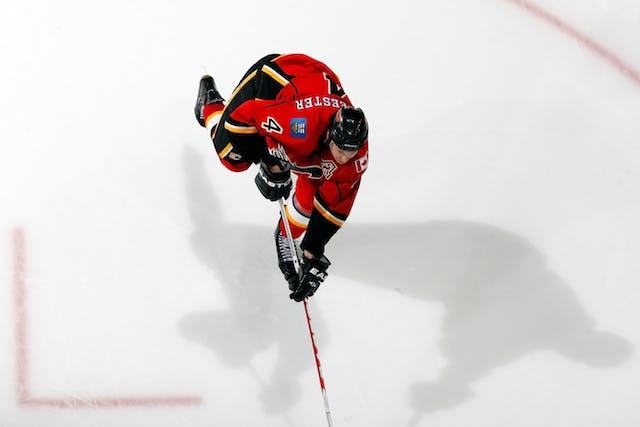Flames in review: Brent Sutter

I wasn’t particularly impressed with Brent Sutter’s work last season, to be frank. The Flames took a significant step backwards in terms of their play, relying on shot suppression and Miikka Kiprusoff entirely too often on route to a 90 point season and 10th place in the Conference. Given that the Flames have just finished 10th yet again, it might be sensible to think that he wasn’t much better this year, but there a few items of interest that suggest that he might have learned a few things over the course of the last two seasons.
George Johnson’s piece earlier today in the Herald hints that big bro was sticking his fingers in places he shouldn’t have, so the possibility exists that Brent never had a free hand until late December of this year. It’s a bit sad if that’s really so, obviously. It wasn’t like Darryl should have concentrating on other matters, right?
Before we get too far gone, I’m of the belief that a coach can only do so much. He really can’t make a goalie stop a puck, or help a forward hit the net with a shot, or assist a defenceman in their puck handling. If they could help with last last one in particular, I’m aware of a right-shooting Flames’ defenceman with a 3.6M cap hit and a NMC that could use a bit of work.
In all seriousness, NHL players as elderly as most of the Flames have generally completed their development on a individual level, so the primary boost a coach can give is when he manages ice time in a sensible manner within the restraints of the available personnel. In other words, asking Mikael Backlund to play tough minutes in the manner of Manny Malhotra wouldn’t make much sense, since Backlund would likely get lit up in that scenario. Horses for courses, and all that.

The overwhelming majority of NHL coaches do this stuff fairly readily, so even if a coach is a master of sensing a weak spot that could be exploited, the edge he might gain over other bench bosses is pretty slight as a rule, and you still need players that can take advantage of that sort of tactical nous. Randy Carlyle might be as good as there is at assessing a situational advantage, but having Ryan Getzlaf and Corey Perry in his back pocket likely makes him look even sharper than he is.
Last year felt, at least to me, like a perpetual season of square peg/round hole stuff from Brent Sutter. He rolled Jokinen and Iginla out there as a regular duo until Jokinen was relocated at the beginning of February even as the pair scuffled along in an underwhelming fashion. The Flames almost never used their best EV forwards, Daymond Langkow and Rene Bourque, alongside Iginla absent a few occasions. The results were, as all of us witnessed, not the prettiest.
Sutter also paired Steve Staios with Jay Bouwmeester for the stretch run in the spring of 2010, relegating the clearly superior Mark Giordano to the third pairing contrary to the evidence on the ice. Those were just the most glaring examples of roster mismanagement in a year that also saw a curious desire to regularly use the fourth line for the ensuing faceoff after the opposition had iced the puck.
To add to my frustration, the Flames played a one-in forecheck almost without fail, and I think the numbers spoke for themselves. The club generated the 8th worst 5v5 shots/60 rate in the league at 28.3, and were barely above water in terms of shot differential, allowing 27.7/60 for a measly .6 edge.
You could make an argument that the Flames had better forwards this season, with the additions of Tanguay and Morrison bolstering the club, but since Daymond Langkow only played 4 games all year, most of that edge was wiped out. The club also had three acceptable top four defencemen for the majority of the season, which by my math would be roughly one short of the minimum requirement.
So, with a collection of question marks at his disposal, what did we see from Sutter? First, although Olli Jokinen had the toughest competition, the spread between Olli’s 1st and David Moss’ 7th was fairly tight, which suggests that Sutter never really settled on any clear hard-minutes option. I don’t think that anyone watching would be too surprised by that, as the Flames did a lot of mix and match even before Morrison and Moss were hurt late in the year. I can’t say I blame Sutter for juggling things, either, because absent Langkow or some other proven commodity, their weren’t many palatable options available.
In terms of lines, it didn’t take Sutter long to bust the Jokinen-Iginla-Tanguay line, and sensibly so. Simply adding Alex Tanguay to that duo wasn’t the elixir required to make things work, and Jokinen found a safe haven working with Moss and Glencross through the middle of the year. The Flames used Brendan Morrison as the center between Iginla and Tanguay, and the trio survived, although they never really dominated the other team’s better players at any point.

Matt Stajan, Nik Hagman and Rene Bourque bounced around more than the other expensive forwards, and the trio’s indifferent results left the fanbase slightly on edge regarding their contributions. The Flames cut the cord on Ales Kotalik, at least in practical terms, as Sutter rarely utilized him before he was waived and sent to Abbotsford. Good riddance.
Tim Jackman and Mikael Backlund had the easiest go in terms of competition and ZoneStart numbers, and they performed well against those players, with fine outshooting performances. Using Backlund in a sheltered role was quite wise on Sutter’s part. I get the desire to push the young man ahead, but he’s still got a few things to learn at both ends of the ice, so a gentle beginning to his career was in order.
In terms of ZoneStarts, it was more of the same, as the Flames primary forwards were in a very tight range. Alex Tanguay finished the year with the easiest O-zone start % at 55.4, while Brendan Morrison’s 50.7% was the toughest. In contrast, the Sedins were in the 70’s while Manny Malhotra had a O-zone start % of 25.0, so you can see that unlike Vigneault or Quennville, Sutter didn’t bury anyone in particular. Again, not having a proven tough minutes option likely made this choice the only acceptable one for the coach.

On defense, the early season trade of Ian White opened the door for a Regher-Bouwmeester pairing, which, like the team, appeared pretty decent until the last month or so. Mark Giordano was paired with Cory Sarich against second level comp, and Sutter was meticulous about sheltering Anton Babchuk, Adam Pardy and Steve Staios from difficult competition or ZoneStarts. Fairly reasonable, given the talents of the men at hand, and Anton Babchuk’s wallet likely will owe Brent Sutter a round of thanks come July 1.
So, in terms of the things he could control, Sutter mixed his main forwards against the other team’s better players in a slightly vain hope that some combination would take hold. It never happened, but as I mentioned, I get why he did it. He did hard-match his top defence pair, again for utterly rational reasons. The results?
Not openly terrible, all things considered. The Flames increased their 5v5 shots/60 to 29.8, 15th best in the league. The shots against number held in place, as the club allowed 27.5 shots/60, 4th best in the NHL. The differential of 2.3 shots/60 was 8th best in the NHL. Perfectly acceptable, really. More shots, a few less against, what’s not to like?
Now, score effects do have their place, but thanks to Time on Ice, we can strip some of that clutter away. I ran the numbers for the top ten Western Conference teams earlier today, and although the full results will be the subject of another post, the Flames had the 5th best Fenwick (shots and missed shots) percentage when the game was tied of those ten teams, behind Chicago, San Jose, Detroit and Vancouver.
They had 52.0% of the Fenwick events when tied, which was an improvement from last year’s 51.4. Fenwick when tied usually tracks fairly well with scoring chances when tied, which is why it’s a good number to look at as a comparable, since we don’t have scoring chance data from all the teams. With that in mind, I suspect that when Kent parses his numbers, the Flames will have out-chanced the bad guys by a reasonable margin.
Special teams are always harder to suss out, to my mind. The Flames had good percentages driving their PP, but they were a bit below average in terms of shots for, and well behind teams like Anaheim or San Jose, but again, talent has it’s role to play in that scenario.
The Flames were in the middle of the pack in terms of shots allowed on the PK, and I didn’t really like their game 4v5. Slow-footed D don’t win many races to loose pucks, of course, and the Flames are bit challenged in that department at the moment, so I’m not sure what a coach could do to repair the problem.

I can’t really hit Brent Sutter too hard for anything that happened this year. His brother left him a roster with many decent players, but no power vs. power option at his disposal, and his best EV forward played all of four games. His other best bet at EV, Moss, missed the last three weeks at a time where the club needed all hands on deck to have a prayer, so by the end of the year the team was in full scramble mode, and I’m not sure what any coach could have done to alleviate that problem.
Overall, I think Sutter corrected a few of his mistakes from 09/10. Not defaulting to Staios-Bouwmeester or Jokinen-Iginla after the early part of the year were positive moves, and I think he’s handled Mikael Backlund’s development nicely. Given his roster, I’m not sure he could have done too much more this year. I’m a hard marker, so I’ll give him a gentleman’s B for his handiwork, and if he’s the coach next season, I’ll have no major quibbles with that decision.
Recent articles from Robert Cleave





